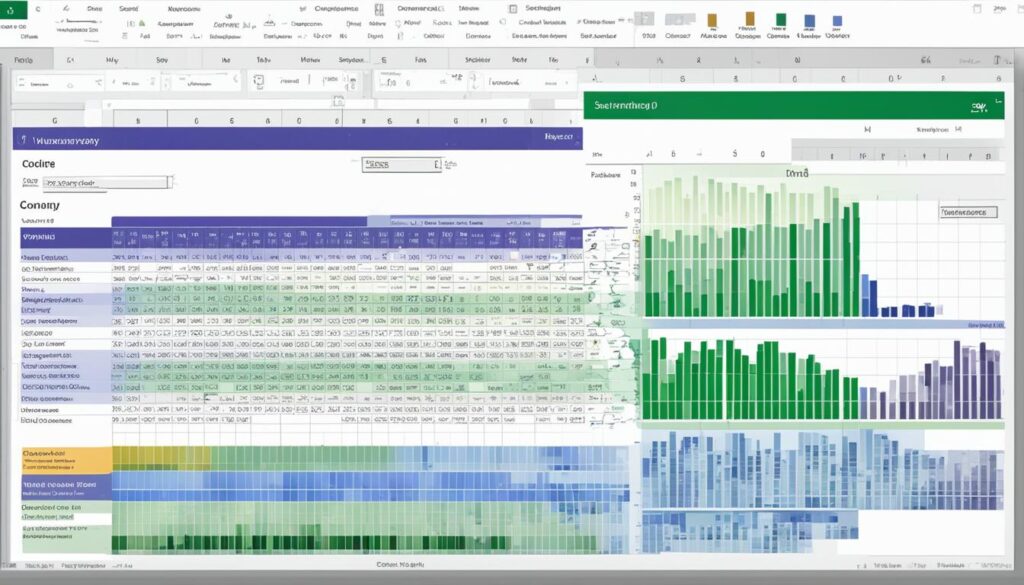In the dynamic landscape of South African markets, harnessing a robust Excel inventory management system is more than a convenience—it’s a competitive advantage. As businesses strive to streamline stock control and amplify business efficiency, Excel emerges as a pivotal tool in achieving these objectives. Through its advanced data analysis capabilities and a user-friendly interface, Excel equips South African companies with the resources necessary to maintain optimal inventory levels, curtail stock shortages or surpluses, and implement data-driven decisions that propel business growth.
The adaptability of Excel allows for real-time tracking, identifying trends, and generating custom reports, which are integral components for enterprises targeting longevity and increased profit margins. By adding an Excel inventory management system into their operational framework, businesses stand to revolutionize how they handle stock, optimize their inventory processes, and position themselves at the forefront of market changes.
Key Takeaways
- Excel enables businesses to enhance stock control with its comprehensive data analysis tools.
- Custom reporting and real-time tracking in Excel contribute to improved business decision-making.
- A user-friendly platform, Excel is ideal for businesses in South Africa to manage and optimize inventory.
- With Excel, companies can minimize the likelihood of stock shortages or excesses.
- Data-driven strategies supported by Excel inventory systems promote sustainable business growth.
Introduction to Excel Inventory Management
The myriad benefits of using Excel for inventory can transform the way businesses approach their inventory management processes. Among the key advantages, Excel’s versatile functions stand out, significantly enhancing stock tracking efficiency. When applied correctly, these functions not only streamline the process of managing physical stock but also contribute to methodical data organization, an indispensable aspect of precise inventory control.
Utilizing Excel for inventory management invites a level of flexibility that’s difficult to achieve with other systems. The platform is ideal for businesses aiming to establish solid foundations for stock handling without incurring prohibitive costs. This cost-effective feature extends to both burgeoning startups and established companies in South Africa, which can tap into Excel’s capabilities to complete complex tasks like auditing, reordering, and tracking sales with surprising ease.
“Implementing Excel for inventory management simplifies the maze of product handling and opens doors to data-backed strategic decision-making that propels businesses forward.”
As we delve deeper into Excel’s utility in this domain, it’s clear that it offers more than just rudimentary tracking. The software provides an all-encompassing solution that touches on every facet of inventory management. For example, detailed analytics afforded by Excel’s powerful formulas empower businesses to anticipate market demands, adjust stock levels proactively, and significantly reduce instances of overstock or stockouts.
| Excel Functionality | Inventory Benefit |
|---|---|
| Conditional Formatting | Hassle-free highlighting of critical stock levels |
| Data Validation | Ensures accurate entry of stock information |
| PivotTables | Facilitates quick summarization and analysis of inventory data |
| Formulas and Functions | Automates calculations for inventory valuation and reordering |
Ultimately, the benefits of using Excel for inventory make it an appealing and viable option for South African businesses of all sizes. Through meticulous stock tracking and data organization, Excel supports the development of more efficient stock management policies, ensuring that enterprises are well-equipped to face the dynamic challenges of the market.
Why use Excel for inventory management?
For businesses seeking efficient inventory management without the high costs typically associated with specialized software, Microsoft Excel is a formidable tool. It’s a powerful ally in the quest for inventory tracking that is both accessible and sophisticated. Below we explore why an Excel inventory template often becomes the go-to choice for businesses aiming to optimize their stock levels intelligently and affordably.
The Familiarity and Versatility of Excel
Excel’s ubiquitous presence in the business world has made it a familiar platform for many users. Its versatility lies in the rich features that allow for detailed data analysis. An Excel inventory spreadsheet can go beyond simple lists; it can become a dynamic document where real-time updates and complex calculations inform inventory decisions.

Cost-Effective Inventory Tracking
When it comes to managing inventory, startups and small businesses in particular benefit from Excel’s cost-effectiveness. Excel vs inventory software is a common consideration, and the former wins out for those requiring a reliable solution that doesn’t strain the budget. Excel negates the need for heavy investment in niche software, proving a vital cost-saving measure for small-scale operations.
Customizable Inventory Management Solutions
One of Excel’s greatest strengths is its customizability. Businesses are not confined to a one-size-fits-all approach; rather, they can define their own Excel inventory template, tailoring it to their unique requirements. Whether it’s adding specific formulas or designing a dashboard that presents key metrics, Excel’s adaptability makes it possible to create highly tailored inventory management solutions that align with individual business processes.
The discussion of Excel inventory spreadsheet flexibility, Excel inventory template cost-effectiveness, and Excel vs inventory software debate reveals a clear picture: Excel offers a robust platform for businesses to manage their inventory with precision, customization, and control.
Essential Excel Tools for Inventory Control
Mastering Excel formulas is at the heart of developing efficient inventory control mechanisms. They are the crux of a well-oiled system that ensures inventory reports are not just numbers on a screen but translate into actionable, data-driven decisions. These versatile formulas allow for in-depth analyses of inventory patterns, essential to maintaining the delicate balance of stock levels.
By harnessing these tools, South African businesses can optimize their inventory management, creating a seamless process for identifying when to reorder and how much to purchase. This precise level of control can drastically improve a company’s operational efficiency and cost-effectiveness.
A prime example of Excel’s capabilities is evident in the use of forecasting and decision-making models:
- Reorder Point Formula: Determines the right time to reorder stock based on consumption rate and lead time.
- Economic Order Quantity: Calculates the optimal quantity to order that minimizes total inventory costs.
- ABC Analysis: Classifies inventory into three categories to prioritize management efforts.
The creation of tailored inventory reports is another advantage Excel offers to businesses. These reports, populated with real-time data and analysis, equip managers with the insight needed to forecast demand and plan for future stock requirements.
| Inventory Report Type | Benefits |
|---|---|
| Stock Summary | Provides a snapshot of current stock levels and values. |
| Purchase Order Report | Tracks orders placed, facilitating supplier performance review. |
| Sales Analysis | Reveals trends and seasonal demand to inform restocking. |
| Financial Overviews | Consolidates cost implications for broader financial impact assessments. |
Furthermore, the automation features within Excel, such as macros and pivot tables, provide dynamic methods to visualize inventory at a glance and adjust strategies accordingly, ensuring that the data drives every stock replenishment decision.
In conclusion, Excel’s robust suite of formulaic and reporting tools can significantly uplift a South African business’s inventory management strategies. When embraced fully, these tools catalyze smarter, more efficient operations that pave the way for sustainable business growth.

Creating Your Excel Inventory Management System
The backbone of a reliable inventory management system is the seamless integration of Excel inventory tracking, automation in inventory management, and the adept use of Excel data analysis to streamline data entry and facilitate accurate stock evaluation. By weaving these elements together, businesses in South Africa can cultivate a system that not only succinctly manages inventory but also adapts to the evolving demands of the market.
Setting Up Effective Inventory Templates
Compiling your procurement and stock information into an accessible format begins with custom-tailored inventory templates. These are the reference points for your product counts, order dates, and supplier data—each entry acting as a snapshot of the company’s supply status at any given time. A well-crafted inventory template reduces complexity and gives a clear, immediate overview of your inventory landscape.
Utilizing Data Validation and Entry Automation
To augment the precision of inventory management, harnessing the power of data validation and entry automation is essential. It mitigates the risk of human error and expedites the process of capturing key inventory metrics. By programming these features into your Excel sheets, you can secure a robust tracking system that safeguards data integrity and enhances productivity.
Implementing Formulas for Accurate Calculations
At the heart of a versatile Excel inventory management system is the strategic implementation of formulas. Through diligent Excel data analysis, you can discern patterns and projections that influence inventory requisitions. Critical formulas include those for calculating reorder points, lead times, and safety stock—enabling businesses to anticipate needs and act accordingly, thereby ensuring continuity and efficiency in inventory replenishment.
| Inventory Metric | Description | Excel Formula Example |
|---|---|---|
| Reorder Point | Determine when to reorder stock | =AVERAGE(lead_time_sales)*AVERAGE(daily_sales) |
| Lead Time | Time taken to restock | =TODAY()-order_date |
| Safety Stock | Extra stock to prevent stockouts | =Z_SCORE*(standard_deviation) *SQRT(lead_time) |
Implementing such targeted calculations allows for precision in managing inventory volumes, ensuring that businesses keep pace with demand without overcapitalizing on unsold stock. The ultimate goal is a harmonized balance between the availability of products and the financial health of the company, driven by intelligent, data-backed decision-making.
Strategies for Stock Control and Optimization
Effectively managing inventory in a South African business environment requires meticulous planning and strategic application of stock control policies. A key component of this is determining precise reorder points, which signal when it’s time to replenish stock. This strategy, deeply integrated within Excel inventory management systems, ensures that safety stock levels stay balanced to accommodate fluctuations in demand and supply chain interruptions, keeping carrying costs optimal.
Implementation of safety stock levels is another critical step in safeguarding against unpredictable demand and lead times. Establishing safety stock levels acts as a buffer to prevent stockouts, thus ensuring continuous operation and customer satisfaction. When incorporated into Excel, such measurements provide a quantitative approach to defining the minimum level of inventory to be maintained at all times.
In the realm of stock optimization, the adherence to sound stock control policies cannot be overstated. These policies drive the accuracy of inventory measures and manage the fine line between overstocking and stockouts. As these policies are backboned by historical sales data, seasonal trends, and forecasting models, they become a powerful tool within Excel, helping businesses visualize and adjust their inventory management practices proactively.
| Strategy | Action | Purpose |
|---|---|---|
| Setting Reorder Points | Calculate optimum reorder levels based on sales velocity and lead time | Timely restocking to avoid stockouts and lost sales |
| Maintaining Safety Stock | Determine buffer inventory levels to cover unforeseen demand spikes | Ensure continuous product availability |
| Applying Stock Control Policies | Develop and enforce rules for when to order stock and how much to order | Balance carrying costs and maintain inventory accuracy |
Through such targeted strategies within Excel, businesses are empowered to streamline procurement procedures and adapt stock levels dynamically. The agility afforded by Excel for maintaining stock control cannot be understated, making it a tool of choice for South African enterprises aiming to hone their competitive edge and support sustainable growth.
Analyzing Inventory Data with Excel
With Excel’s robust capabilities, businesses can dive deep into inventory data analysis, transforming numbers into strategic insights. From observing historical sales to predicting future trends, Excel is a powerhouse for understanding and reacting to market conditions with precision and agility. Let’s explore how Excel aids in evaluating inventory performance.
Demand Forecasting and Seasonal Analysis
Understanding customer demand is a vital component of inventory management. Excel demand forecasting employs historical sales data to predict future needs, helping businesses stay one step ahead. Seasonal trends can significantly impact demand, and with Excel, businesses can identify these patterns, ensuring they are never caught off-guard by a sudden surge or drop in sales.
Utilizing Advanced Data Analysis Functions
Advanced data analysis features in Excel go beyond the basics, offering an in-depth look at inventory health. By analyzing data sets with complex functions, businesses can track inventory with granular detail, identifying which items are performing well and which need attention. This level of inventory data analysis is essential for making informed decisions that can lead to increased efficiency and reduced waste.
Visualizing Data with Tables and Charts
Visualization tools in Excel allow businesses to create meaningful representations of data, enhancing the comprehension of inventory performance visualization. By transforming data into charts and tables, patterns and insights become immediately evident, promoting a clearer understanding and facilitating swift decision-making.
| Month | Demand Forecast | Actual Sales | Variance |
|---|---|---|---|
| January | 200 | 190 | -5% |
| February | 250 | 265 | 6% |
| March | 220 | 210 | -4.5% |
| April | 190 | 180 | -5.3% |
| May | 300 | 320 | 6.7% |
Take notice of the table above which demonstrates an exemplary comparison between Excel demand forecasting and actual sales over consecutive months. The ‘Variance’ column is pivotal, as it highlights the degree of accuracy in forecasts and provides a benchmark for refining future predictions.
Conclusion
Ultimately, the advantages of Excel for inventory management are both varied and extensive. South African businesses of various sizes have found considerable benefits in this dynamic tool, which aids in crafting a highly efficient approach toward managing stock. Excel’s natural playground of data manipulation and analysis provides a sturdy foundation for businesses to not only maintain inventory but also to optimize inventory levels meticulously. These optimized levels embody the principle of lean stock management by seamlessly balancing supply with demand, minimizing excesses, and precluding shortage scenarios.
Moreover, Excel’s cost-effectiveness is particularly attractive for small to mid-sized businesses looking to streamline operations without the burden of weighty financial investments. The ability to customize Excel means that each business can develop a package of tools and formulas that speak directly to their unique inventory circumstances. The capacity for personalization within Excel is not simply a feature—it is a strategic advantage that, when utilized correctly, can translate into significant operational savings and heightened inventory accuracy.
Consistent application of proven inventory management practices through Excel is an investment in business growth. As entities in South Africa consciously pivot towards data-driven decision-making, Excel emerges as a central cog in this transformative journey. It is a triumph of familiar software delivering on the promise of business scalability. For any business aiming to advance its inventory management protocols, Excel stands as an instrumental asset capable of steering toward sustainable growth and resilience against the complexities of inventory challenges.







